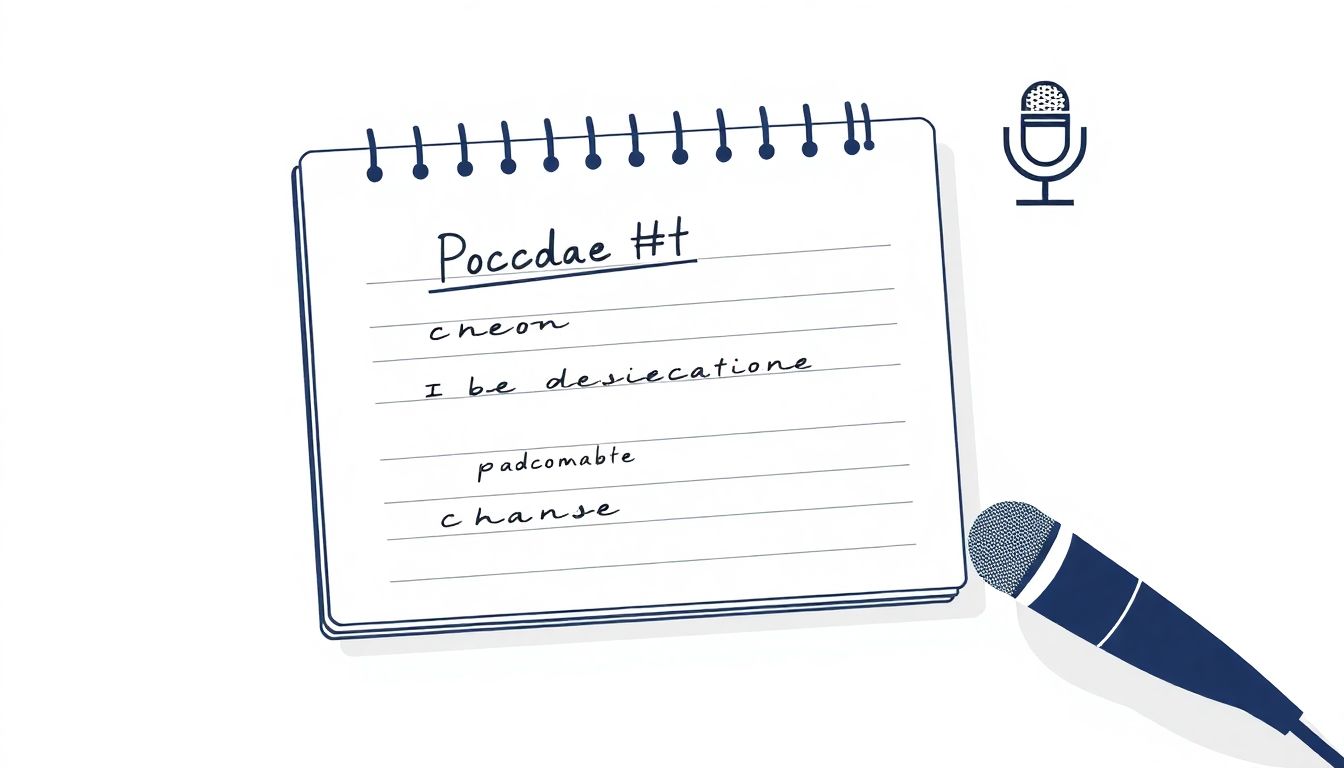I get it—podcasting sounds fun, but figuring out how to actually start can feel overwhelming, especially if you’re new to this. So many decisions, from finding the right gear to knowing what to talk about!
Here’s some good news: by following a few clear steps, you’ll be able to set up your podcast easily, attract the right listeners, and start feeling more confident about your content.
Stick around, I’ve got eight straightforward steps that’ll guide you smoothly from planning to growing your podcast audience.
Key Takeaways
- Clearly define your podcast’s purpose and ideal listener before starting.
- Focus on great audio quality with decent equipment like a good microphone and noise-reducing headphones.
- Prepare several episodes upfront to encourage binge-listening and gain subscribers early.
- Use outlines or scripts for organized content and smooth delivery.
- Invite guests relevant to your genre and audience interests through social platforms and online groups.
- Publish episodes at regular intervals to maintain listener trust and grow your audience.
- Actively share your podcast through social media, short videos, audio clips, and email lists.
- Regularly check listener feedback and reviews to improve future episodes based on their suggestions.

Step 1: Decide Your Podcast Purpose and Ideal Listener
This first step might feel straightforward, but trust me—it’s the most crucial part of starting a podcast that actually reaches people. Before setting up equipment or planning episodes, clarify your podcast’s purpose and exactly who you’re talking to.
Ask yourself specific questions like: Do I want to entertain readers, teach them something new about a particular genre, or share behind-the-scenes tidbits from my books? Deciding your clear “why” helps listeners connect better with you. For instance, an author who primarily writes horror novels might create a podcast diving into creepy legends, horror writing techniques, or generating new horror story ideas. Knowing precisely who your listeners are—their age range, interests, favorite books, and habits—makes creating content easier and more accurate.
Pro tip: Write down a quick description of your “ideal listener”—like “An avid reader in their late-twenties who enjoys historical fiction and listens during their commute.” Having this clear vision shapes your podcast’s tone, length, subject matter, and even guest choice, giving your podcast higher chances of building a loyal audience.
Step 2: Set Up Your Podcast with Quality Audio
Now here’s a truth bomb: listeners can forgive occasional awkward silences or small stumbling in speech—but poor, scratchy audio? That’s an immediate “unsubscribe.” Podcasts are an audio-first medium, so invest in decent equipment from the start.
You don’t need a studio-quality setup right away, but a good microphone like the Blue Yeti or the Audio-Technica ATR2100x-USB will significantly improve your recording quality. You’ll also want noise-reducing headphones, a pop filter to manage those sharp “p” and “t” sounds, and audio editing software like Audacity (free) or Adobe Audition.
Test your equipment in various spaces to find a quiet environment. Also, think about adding simple soundproofing—like blankets, rugs, or foam panels—to reduce echo for clearer recordings. Remember, clear audio isn’t a luxury; it’s basic podcast hygiene.
Step 3: Plan Multiple Episodes Ahead of Launch
Here’s the fun part. Before hitting “record,” map out at least three to five episodes ahead of your podcast launch. Why multiple episodes? It encourages new listeners to binge your content right from the start, giving them a solid feel for your show and increasing the likelihood they’ll subscribe.
Plan episodes around clear, engaging topics closely tied to your books or genre. For example, if you’re a children’s author, your first episodes might cover storytelling tips, creative kids’ book ideas, or interviews with successful authors in children’s fiction.
Each episode should have an intriguing title, description, and bullet-point outline for content segments, helping keep your episodes on-point and valuable to listeners. Adding timestamps and topic headings in your podcast notes and website show pages also boosts your discoverability through SEO (Search Engine Optimization), attracting listeners who search for these topics on Google.
By 2026, podcast listening is expected to peak at around 619 million people globally, compared to 450 million today—so strategize your content early, and you’ll be way ahead of the growing listener base.

Step 4: Create an Easy-to-Follow Podcast Outline or Script
If you’re wondering if you really need a script or outline—yes, you absolutely do.
An outline helps keep your episodes organized and makes speaking naturally way easier.
Listeners notice when an episode is structured versus when you wing it—you know, those rambling podcasts where one episode feels twice as long as necessary.
Your outline doesn’t have to be word-for-word, but it should at least have key points, transitions, and reminders.
Start with a short opening hook—just one or two sentences about what listeners will get if they stick around to the end.
Then organize your main content into straightforward sections or bullet points; think “5 tips,” “3 ways,” or even a list of interesting facts related to your episode topic.
If you’re stuck on topics, you can find fun prompts online or even try funny writing prompts for kids; these could spark ideas if you’re targeting a younger audience or simply wanting a playful podcast segment.
Always wrap up your episodes clearly, summarizing points quickly and inviting listeners to subscribe or interact on social media.
Step 5: Find Guests That Match Your Book’s Audience
You want great guests that interest your listeners but also align closely with the audience of your books.
First, look at authors who share your genre—you can reach out on platforms like Twitter, Instagram, or LinkedIn where writers are usually happy to talk shop.
Professionals related to your book’s themes work too; for instance, historians if you’re into historical fiction or illustrators if you write children’s books.
Another good idea: join author or reader groups on Facebook, Reddit communities focused on your topic, or even writer meetups in your local area.
And here’s a trick—often, people searching something like how to publish without an agent, might love to be guests and discuss their journeys.
Invite guests clearly (mentioning your podcast name, audience type, and possible discussion topics upfront), schedule them using easy tools like Calendly, and provide clear instructions on technical setup needed for recording.
Step 6: Publish New Episodes on a Consistent Schedule
The simplest—and hardest—tip for podcast growth is consistency.
Publishing episodes regularly helps listeners make your show a habit, increasing downloads, listens, and subscriptions.
It’s better to consistently deliver one episode weekly rather than dropping three episodes in one week, then none after that.
Tools like Anchor, Libsyn, or Buzzsprout can schedule podcast episodes easily ahead of time—use them for seamless publishing without stress.
Pick your ideal frequency realistically based on your schedule; weekly is popular, but even every two weeks works if done consistently.
Let listeners know clearly when to expect new episodes, mention it in your outro, or place it prominently on your podcast’s website and social media.
Step 7: Promote Your Podcast on Social Media and Other Channels
No matter how amazing your podcast is, listeners won’t magically appear; you’ve got to promote actively.
Create engaging graphics with tools like Canva or Adobe Express to announce new episodes clearly on Instagram Stories, Twitter, and Facebook groups related to your topic or book genre.
Use short audio or video highlights across TikTok, Instagram Reels, or YouTube Shorts to tease quality moments from recent episodes.
Don’t overlook platforms like LinkedIn if your target audience includes professionals or educators who may enjoy your content.
If relevant, join book or podcast groups online, but avoid spam—listen, participate, then thoughtfully recommend episodes only when truly helpful.
Another simple yet effective channel: your own email list; loyal readers often become enthusiastic listeners too.
Step 8: Check Listener Feedback and Improve Your Podcast
Listener feedback isn’t something you collect passively—it’s literally a goldmine to making your podcast better and more successful.
Monitor comments, reviews, and direct messages regularly across podcast platforms like Apple Podcasts, Spotify, Stitcher, or even YouTube.
Ask for feedback directly in your episode outros—something like: “I’d love your thoughts on today’s topic—DM me on Instagram or leave a review.”
Pay close attention to listener suggestions, repeating topics they request often, or advice that genuinely improves your content.
Consistent trends in feedback can mean you need shorter intros, clearer episode descriptions, or better guest preparedness—adjust these aspects immediately.
Every bit of audience feedback helps your podcast meet listeners’ actual needs, getting you higher ratings and making sure listeners keep coming back.
FAQs
Start by identifying common interests, challenges, or topics featured in your book. Consider your readers’ demographic, needs and goals. Clearly defining your listener helps you create relevant content that connects directly with your audience.
Invest in a reliable microphone, headphones, audio interface, and a recording/editing software like Audacity or Adobe Audition. Select equipment within your budget that ensures your podcast audio sounds clear, professional, and easy for listeners to enjoy.
Select a release schedule you can maintain realistically, like weekly or bi-weekly. Consistency helps listeners anticipate your episodes and builds loyalty. Inform your audience of the schedule and stick to it to steadily grow your podcast.
Identify authors, influencers, or experts that align closely with your book and audience. Reach out directly through email or social media, emphasizing how their guest appearance would resonate specifically with the interests of your listeners.